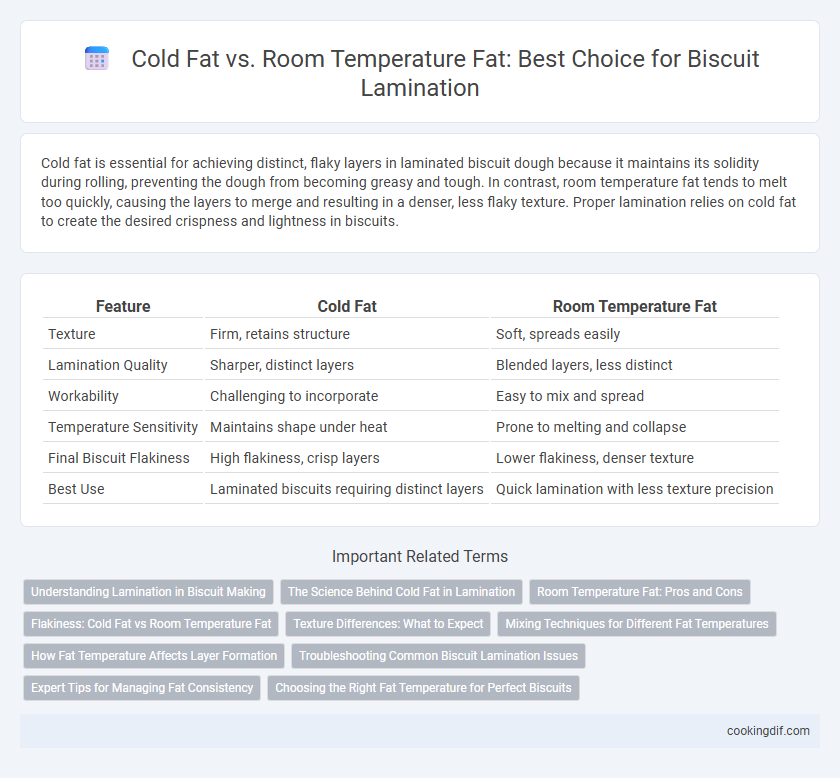Cold fat is essential for achieving distinct, flaky layers in laminated biscuit dough because it maintains its solidity during rolling, preventing the dough from becoming greasy and tough. In contrast, room temperature fat tends to melt too quickly, causing the layers to merge and resulting in a denser, less flaky texture. Proper lamination relies on cold fat to create the desired crispness and lightness in biscuits.
Table of Comparison
| Feature | Cold Fat | Room Temperature Fat |
|---|---|---|
| Texture | Firm, retains structure | Soft, spreads easily |
| Lamination Quality | Sharper, distinct layers | Blended layers, less distinct |
| Workability | Challenging to incorporate | Easy to mix and spread |
| Temperature Sensitivity | Maintains shape under heat | Prone to melting and collapse |
| Final Biscuit Flakiness | High flakiness, crisp layers | Lower flakiness, denser texture |
| Best Use | Laminated biscuits requiring distinct layers | Quick lamination with less texture precision |
Understanding Lamination in Biscuit Making
Cold fat in biscuit lamination creates distinct, flaky layers by maintaining its solidity during folding, which prevents the fat from mixing fully with the dough. Room temperature fat, being softer, integrates more with the flour, resulting in a denser, less flaky texture. Precise control of fat temperature is essential for achieving optimal lamination and the characteristic flaky structure in laminated biscuit products.
The Science Behind Cold Fat in Lamination
Cold fat maintains its solid state during lamination, creating distinct layers by preventing premature melting into the dough; this solid fat traps steam when baked, producing the desired flaky texture in biscuits. Room temperature fat, being softer, blends more with the dough, reducing lamination effectiveness and resulting in denser, less flaky biscuits. The differential melting point of cold fat is crucial for achieving optimal layer separation and light, airy biscuit crumb through proper lamination.
Room Temperature Fat: Pros and Cons
Room temperature fat improves malleability and integration during lamination, producing flakier biscuit layers due to its softer consistency. However, it can increase dough stickiness, making handling more challenging and potentially leading to less defined lamination layers. Room temperature fat may also slow down the lamination process as it requires careful temperature control to prevent over-softening and loss of structure.
Flakiness: Cold Fat vs Room Temperature Fat
Cold fat produces superior flakiness in biscuits by creating distinct layers of dough and fat as it melts during baking, resulting in a tender, flaky texture. Room temperature fat blends more thoroughly into the dough, yielding a denser, less flaky crumb with reduced layering. For optimal lamination and crisp, flaky biscuits, maintaining fat at cold temperatures is essential.
Texture Differences: What to Expect
Cold fat in biscuit lamination creates distinct, flaky layers by preventing premature melting, resulting in a crisper texture. Room temperature fat blends more fully with the dough, producing a tender, less flaky crumb. Expect cold fat to deliver sharper layer separation, while room temperature fat yields a softer, more cohesive biscuit structure.
Mixing Techniques for Different Fat Temperatures
Using cold fat in biscuit lamination creates distinct layers through solid fat particles that prevent dough layers from fully blending, resulting in a flakier texture. Room temperature fat, being softer, integrates more thoroughly with the dough, yielding a tender and uniform crumb. Adjusting mixing techniques involves more gentle handling with cold fat to maintain layer integrity, while room temperature fat requires careful emulsification to avoid overmixing and ensure consistent lamination.
How Fat Temperature Affects Layer Formation
Cold fat maintains its solid state during lamination, creating distinct layers by preventing premature melting and blending with dough, resulting in a flakier biscuit texture. Room temperature fat softens and partially melts, causing fat to integrate into the dough, which reduces the separation of layers and yields a denser biscuit structure. Proper control of fat temperature directly influences lamination efficiency and the final biscuit's crumb and flakiness.
Troubleshooting Common Biscuit Lamination Issues
Using cold fat in biscuit lamination often leads to uneven dough layers and poor rise due to insufficient plasticity, causing tearing and shrinking during baking. Room temperature fat improves malleability, ensuring smoother layer separation and better steam expansion for flaky texture. For troubleshooting, ensure fat is pliable but not melted to prevent greasy dough and maintain lamination integrity.
Expert Tips for Managing Fat Consistency
For perfect biscuit lamination, experts recommend using cold fat to create distinct, flaky layers by preventing excessive melting during dough folding. Room temperature fat softens too quickly, leading to less defined layers and a denser texture. Managing fat consistency with precise chilling ensures optimal flakiness and structural integrity in laminated biscuit dough.
Choosing the Right Fat Temperature for Perfect Biscuits
Choosing the right fat temperature for biscuit lamination significantly impacts the final texture and flakiness. Cold fat maintains discrete layers during folding, producing crisp, flaky biscuits by creating steam pockets as it melts in the oven. Room temperature fat blends more completely into the dough, resulting in a softer, more tender crumb but less pronounced lamination.
Cold fat vs Room temperature fat for lamination Infographic

 cookingdif.com
cookingdif.com